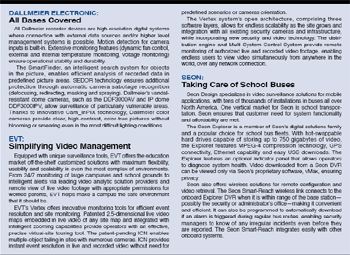Solutions specific to the educational market include linkages between the administration's main student enrolment and security system, which enables mass card or PIN code issuance or disablement for tens of thousands of students at a time with ease. Additionally, this ensures student cards or PIN codes get students only into rooms and labs for classes in which they are enrolled. If students drop classes or fail to pay tuition, the appropriate building and/or door access privileges are revoked automatically. Some security systems include comprehensive lock down as a standard feature; moreover, they link to parking systems, mass-notification systems, cameras, and DVR and NVRs.
Access Control
Solutions specific to the educational market include linkages between the administration's main student enrolment and security system, which enables mass card or PIN code issuance or disablement for tens of thousands of students at a time with ease. Additionally, this ensures student cards or PIN codes get students only into rooms and labs for classes in which they are enrolled. If students drop classes or fail to pay tuition, the appropriate building and/or door access privileges are revoked automatically. Some security systems include comprehensive lock down as a standard feature; moreover, they link to parking systems, mass-notification systems, cameras, and DVR and NVRs.
The next step in an intelligent migration involves computer-managed (CM) locking systems, said Beveryly Vigue, Vice President for the Education Vertical, Ingersoll Rand Security Technologies. CM locks are suited to situations where older doors or facilities need to be retrofitted with higher grade security locks. These stand-alone, programmable, batterypowered locks are networked through software to provide an audit trail.
Beyond CM locking systems are hardwired locks, which let users use a CM-type lock to monitor doors opening with existing, third-party access control panels and software. The open architecture platform seamlessly connects the specially designed door lock to a panel interface board (PIB) that connects to any access control panel. There is no need for separate components or products from multiple manufacturers.
Actual installations demonstrate that a wireless solution can have a substantially lower installation cost than an online access control system. Wireless systems use less hardware and can be installed faster. With wireless systems, it becomes extremely easy to retrofit electronic access control solutions in facilities and applications that had previously been held back due to budget constraints or installation limitations.
Video Surveillance
Many schools and universities also struggle to prevent vandalism by the student population, said Bard. In these cases, it is worthwhile investing in vandal- resistant cameras with rugged enclosures, as well as a system with the capability to trigger alarms if a camera lens is covered by a hand or spray-painted. Image authentication capabilities are also important for using recorded video as evidence in legal proceedings.
resistant cameras with rugged enclosures, as well as a system with the capability to trigger alarms if a camera lens is covered by a hand or spray-painted. Image authentication capabilities are also important for using recorded video as evidence in legal proceedings.
Smaller schools may not have dedicated security personnel or resource officers to operate a system or monitor video, Bard continued. In many cases, assistant principals are tasked with reviewing video when an incident occurs, or administrative assistants must access video from specific cameras to see the person requesting access to the school before they unlock the door. For these schools, it is imperative that systems are easy to use even for non-technical people. For example, the user interface for a DVR needs to have flexible recording schedules and features that make it simple to operate, such as point click functionality to view video from various cameras and hone in on areas that need closer examination.
Daniel Doron, Marketing Manager for ioimage, agreed. "Intelligent video watches large amounts of security video from surveillance cameras. The importance of this is that schools need robust detection; hassle-free installation; and easy-to-use features that do not necessitate extensive learning curves, computer modifications or ongoing maintenance that only big-budget security installations can afford. Today, there are intelligent video solutions on the market that offer just that."
Legacy security systems do not offer adequate solutions, Talmon believes, but the new generation of video analytics can be very effective. With some 100,000 K-12 schools, each with the potential for between $25,000 and $150,000 worth of security systems, and a penetration rate of less than 2 percent for electronic perimeter protection and video analytics, this is a big potential market.
"IT personnel are becoming increasingly involved in implementation of security systems, since many share existing networks previously relegated just for  traditional applications,"said Frank DeFina, President of Panasonic System Solutions. "IP-based video surveillance demands considerable network bandwidth and, the larger the systems, the more significant an impact it has on network operations. There is a balance that needs to be achieved to support both traditional IT applications without compromising capabilities of an IP-based video surveillance system."
traditional applications,"said Frank DeFina, President of Panasonic System Solutions. "IP-based video surveillance demands considerable network bandwidth and, the larger the systems, the more significant an impact it has on network operations. There is a balance that needs to be achieved to support both traditional IT applications without compromising capabilities of an IP-based video surveillance system."
IP-based systems
DeFina has seen rising demand for IP-based systems that allow school administrators and security personnel to easily access live video images over networks, and even remotely via the Internet or wireless devices. Networked video surveillance systems also allow for a higher level of integration with related security systems such as access control and visitor management systems where specific sequences of events can automatically trigger alarms and notifications.
IP technology has brought a common language for integrating systems, said Bard. And, while ability to integrate is available, not every system should be 
incorporated. A successful project begins with a frank, thorough discussion of needs, goals and budgets. It is important to keep in mind that getting the most accurate, up-to-date information from an integrated system does not happen simply because subsystems are networked. Bidirectional communications ensures that information is transmitted between hardware and software automatically and as quickly as possible. This is paramount in an emergency situation where decisions are made based on snapshot assessments.
Integrated systems should also be built around a unified database, which enables transfer of applicationrelated information between subsystems and ensures that this information is kept up-to-date. For example, updates to human resource or enrollment information when employees are hired or students leave the school or university should automatically be made to the access control database. A delay of minutes or hours could provide an opportunity for a disgruntled employee or student to inflict damage to property.
Benefits of integration are further enhanced by providing a unified look for alarms and other alerts, regardless of origin access control, video surveillance, fire. This allows for a more consistent response from administrators or campus security, and aids in reducing training time for the operator.
Product Adopted:Biometrics